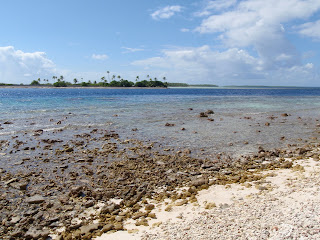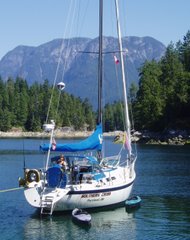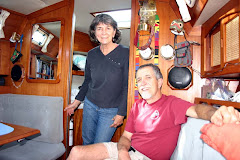We left Raroia at slack tide, with only 80 miles to go to Makemo, and 15 hours until daybreak. With the nice tradewind breeze, it was very hard to slow the boat down below 5 knots, so we hove to for a couple of hours in the lee of Taenga atoll. As we approached the east pass of Makemo just after sunrise, we could see a long stream of turbulence snaking out to sea, due to a strong ebb current. We had no idea how long it would be until slack, so we decided to head in and see how strong the current was. Fortunately, the strongest current was concentrated along one side of the broad channel. By keeping to the other side, we encountered no more than a couple of knots against us, and we were soon inside the lagoon.

We could see one sailboat tied to the new concrete wharf, so we approached to see what it was like. The "Tuamotus Compendium" (Soggy Paws) described the wharf as the best place to tie up near the village, so that's what we did. As we approached, we let out our stern anchor, and then, several young local men offered to take lines from the bow to steel rings on the wharf. We were soon made fast, next to the catamaran "Shibolet" from Israel.

Pouheva village is the largest village in this part of the Tuamotu archipelago.

We immediately headed to the bakery to buy some fresh bread. It was already closed when we got there at 8AM, but the nearby store had baguettes, croissants, and even quiche. It also had the best selection of fresh fruits and vegetables we had seen since arriving in Polynesia. We bought lettuce (from California), tomatoes, green peppers, and cucumbers. We also used the wi-fi connection to check email and update the blog. As we sat on a bench outside the store, we were surrounded by high school girls - all children in this part of Polynesia have to come to Makemo for high school.
Back at the dock we did some snorkeling. It was surprisingly nice, and we saw an octopus, several pipefish, and a number of leopard flounder.


We also met Henk and Marie on "Lady of the Lowlands," a capable Dutch cruiser that had come through the Beagle channel, and stopped at Easter Island and the Gambiers on the way here. They were spending several weeks at Makemo, with the philosophy that "one Tuamotu atoll is like the next."
Be that as it may, we have decided to experience several of the atolls to see what they offer, and one of the reasons we wanted to visit Makemo was to sail through her lagoon to the western pass, 25 miles away. After a very nice day wandering the village, and a peaceful night tied up to the dock, we departed for a pleasant downwind sail in the placid lagoon. There were fewer coral heads than in Raroia, so that we rarely had to alter course.

In the afternoon, we anchored in the lee of a long peninsula of reef, sticking out from the main reef at a right angle and providing excellent shelter from most wind directions. This part of the lagoon was fronted by a beautiful sandy beach and luxuriant groves of coconut palms.

We spent 2 nights here, snorkeling the reef and hiking the beach. The reef had lots of colorful "aquarium fish" and giant clams.


We met two local Paumotu men who were camped on the beach and collecting copra and coconut crabs. One of the men's faces was completely covered with tattoos, making his head appear green from a distance. I dearly wanted to photograph him, but something about their demeanor did not make us want to prolong our contact with them.
Our next stop was the west pass of Makemo, which we wanted to snorkel through at slack water. The "Compendium" mentioned a nearby anchorage in a small cove lined with coral reefs. As we approached, we could see a small beach, a few shacks, and several men spearfishing on the shallow reef. A strong current ebbing through the pass made it tricky to navigate our way into the uncharted cove, but at length we found ourselves in a protected patch of water. It was a bit of work getting the anchor down without fouling the chain on high coral heads, but we managed it. The fishermen took off before we could ask about filling our water jugs, but since the village was otherwise abandoned, we decided it would be OK to help ourselves from one of the several large cisterns here.

The west pass turned out to be the best snorkeling we had yet seen, as it was much narrower and shallower than the pass at Raroia. The flood current was only about 2 knots, so we had time to identify and photograph numerous fish as we drifted along the continuous carpet of living coral.



Back at the boat, we decided that we weren't comfortable enough to spend the night at this anchorage, so we prepared for another overnight passage, this time only 48 miles, to Tahanea.
 We could see one sailboat tied to the new concrete wharf, so we approached to see what it was like. The "Tuamotus Compendium" (Soggy Paws) described the wharf as the best place to tie up near the village, so that's what we did. As we approached, we let out our stern anchor, and then, several young local men offered to take lines from the bow to steel rings on the wharf. We were soon made fast, next to the catamaran "Shibolet" from Israel.
We could see one sailboat tied to the new concrete wharf, so we approached to see what it was like. The "Tuamotus Compendium" (Soggy Paws) described the wharf as the best place to tie up near the village, so that's what we did. As we approached, we let out our stern anchor, and then, several young local men offered to take lines from the bow to steel rings on the wharf. We were soon made fast, next to the catamaran "Shibolet" from Israel.
 Pouheva village is the largest village in this part of the Tuamotu archipelago.
Pouheva village is the largest village in this part of the Tuamotu archipelago.
 We immediately headed to the bakery to buy some fresh bread. It was already closed when we got there at 8AM, but the nearby store had baguettes, croissants, and even quiche. It also had the best selection of fresh fruits and vegetables we had seen since arriving in Polynesia. We bought lettuce (from California), tomatoes, green peppers, and cucumbers. We also used the wi-fi connection to check email and update the blog. As we sat on a bench outside the store, we were surrounded by high school girls - all children in this part of Polynesia have to come to Makemo for high school.
Back at the dock we did some snorkeling. It was surprisingly nice, and we saw an octopus, several pipefish, and a number of leopard flounder.
We immediately headed to the bakery to buy some fresh bread. It was already closed when we got there at 8AM, but the nearby store had baguettes, croissants, and even quiche. It also had the best selection of fresh fruits and vegetables we had seen since arriving in Polynesia. We bought lettuce (from California), tomatoes, green peppers, and cucumbers. We also used the wi-fi connection to check email and update the blog. As we sat on a bench outside the store, we were surrounded by high school girls - all children in this part of Polynesia have to come to Makemo for high school.
Back at the dock we did some snorkeling. It was surprisingly nice, and we saw an octopus, several pipefish, and a number of leopard flounder.

 We also met Henk and Marie on "Lady of the Lowlands," a capable Dutch cruiser that had come through the Beagle channel, and stopped at Easter Island and the Gambiers on the way here. They were spending several weeks at Makemo, with the philosophy that "one Tuamotu atoll is like the next."
Be that as it may, we have decided to experience several of the atolls to see what they offer, and one of the reasons we wanted to visit Makemo was to sail through her lagoon to the western pass, 25 miles away. After a very nice day wandering the village, and a peaceful night tied up to the dock, we departed for a pleasant downwind sail in the placid lagoon. There were fewer coral heads than in Raroia, so that we rarely had to alter course.
We also met Henk and Marie on "Lady of the Lowlands," a capable Dutch cruiser that had come through the Beagle channel, and stopped at Easter Island and the Gambiers on the way here. They were spending several weeks at Makemo, with the philosophy that "one Tuamotu atoll is like the next."
Be that as it may, we have decided to experience several of the atolls to see what they offer, and one of the reasons we wanted to visit Makemo was to sail through her lagoon to the western pass, 25 miles away. After a very nice day wandering the village, and a peaceful night tied up to the dock, we departed for a pleasant downwind sail in the placid lagoon. There were fewer coral heads than in Raroia, so that we rarely had to alter course.
 In the afternoon, we anchored in the lee of a long peninsula of reef, sticking out from the main reef at a right angle and providing excellent shelter from most wind directions. This part of the lagoon was fronted by a beautiful sandy beach and luxuriant groves of coconut palms.
In the afternoon, we anchored in the lee of a long peninsula of reef, sticking out from the main reef at a right angle and providing excellent shelter from most wind directions. This part of the lagoon was fronted by a beautiful sandy beach and luxuriant groves of coconut palms.
 We spent 2 nights here, snorkeling the reef and hiking the beach. The reef had lots of colorful "aquarium fish" and giant clams.
We spent 2 nights here, snorkeling the reef and hiking the beach. The reef had lots of colorful "aquarium fish" and giant clams.

 We met two local Paumotu men who were camped on the beach and collecting copra and coconut crabs. One of the men's faces was completely covered with tattoos, making his head appear green from a distance. I dearly wanted to photograph him, but something about their demeanor did not make us want to prolong our contact with them.
Our next stop was the west pass of Makemo, which we wanted to snorkel through at slack water. The "Compendium" mentioned a nearby anchorage in a small cove lined with coral reefs. As we approached, we could see a small beach, a few shacks, and several men spearfishing on the shallow reef. A strong current ebbing through the pass made it tricky to navigate our way into the uncharted cove, but at length we found ourselves in a protected patch of water. It was a bit of work getting the anchor down without fouling the chain on high coral heads, but we managed it. The fishermen took off before we could ask about filling our water jugs, but since the village was otherwise abandoned, we decided it would be OK to help ourselves from one of the several large cisterns here.
We met two local Paumotu men who were camped on the beach and collecting copra and coconut crabs. One of the men's faces was completely covered with tattoos, making his head appear green from a distance. I dearly wanted to photograph him, but something about their demeanor did not make us want to prolong our contact with them.
Our next stop was the west pass of Makemo, which we wanted to snorkel through at slack water. The "Compendium" mentioned a nearby anchorage in a small cove lined with coral reefs. As we approached, we could see a small beach, a few shacks, and several men spearfishing on the shallow reef. A strong current ebbing through the pass made it tricky to navigate our way into the uncharted cove, but at length we found ourselves in a protected patch of water. It was a bit of work getting the anchor down without fouling the chain on high coral heads, but we managed it. The fishermen took off before we could ask about filling our water jugs, but since the village was otherwise abandoned, we decided it would be OK to help ourselves from one of the several large cisterns here.
 The west pass turned out to be the best snorkeling we had yet seen, as it was much narrower and shallower than the pass at Raroia. The flood current was only about 2 knots, so we had time to identify and photograph numerous fish as we drifted along the continuous carpet of living coral.
The west pass turned out to be the best snorkeling we had yet seen, as it was much narrower and shallower than the pass at Raroia. The flood current was only about 2 knots, so we had time to identify and photograph numerous fish as we drifted along the continuous carpet of living coral.


 Back at the boat, we decided that we weren't comfortable enough to spend the night at this anchorage, so we prepared for another overnight passage, this time only 48 miles, to Tahanea.
Back at the boat, we decided that we weren't comfortable enough to spend the night at this anchorage, so we prepared for another overnight passage, this time only 48 miles, to Tahanea.


No comments:
Post a Comment